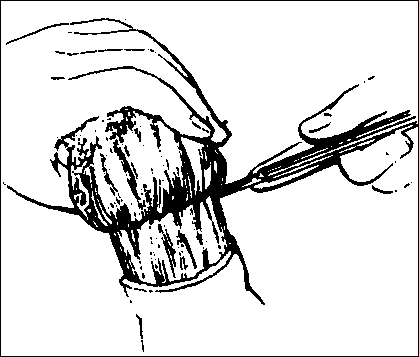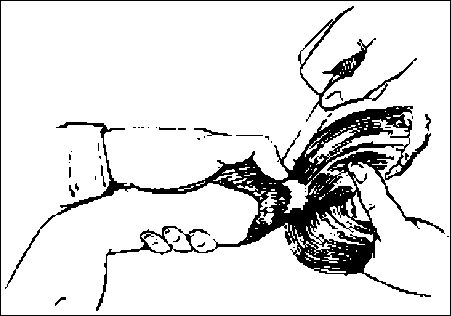<Medical Care During
The American Civil War
Frank R. Freemon
(Illinois)

Out of a total of 2,400,000 soldiers that were mustered up on both sides, mortality figures reached over 600,000. The death rate in battle was moderate --- it was the subsequent devastation of disease, infection in hospitals, and doctors ignorant of sanitation, that killed the larger number of soldiers.
Gangrene and Glory is physically a klunky work. The book design is like something they'd hand out to you in Nathan Hall High for your 10th grade English composition workbook. In addition, it is quite scattered. It goes into great detail about the lives and education of various doctors, lists American Medical Schools in 1860 (there were slightly more than four score), and contains a number of rather peculiar tables: "Union Doctors Released at the Winchester Accord," "Support Hospitals for the Army of Tennessee," "Workers at Chimsborazo Hospital, January 1863" [166 Hospital Stewards, 58 cooks, 123 Laundry Workers], and "Confederate Medical Appropriations."
It is, thus, not at all like reading Barbara Ward, Winston Churchill or Thomas Babington Macaulay. But some of the quotes from those who lived through it are genuine show-stoppers. This from a doctor William Morton, receiving the wounded at Fredericksburg:
It is the most sickening sight of the war, this tide of wounded flowing back. One has a shattered arm, and the sling in which he carries it is the same bloody rag the surgeon gave him the day of battle; another has his head seamed and bandaged so you can scarcely see it, and he weaves like a drunken man as he drags along through the hot sun; another has his shoe cut off, and a great roll of rags around his foot, and he leans heavily on a rough cane broken from a pine tree; another breathes painfully and holds his hand to his side, where you see a ragged rent in his blouse; another sits by a puddle, dipping water on a wounded leg, which , for want of dressing since the battle, had become inflamed; another lies on a plot of grass by the roadside, with his browned face turned full to the sun, and he sleeps.
 The photographs, etchings, and drawings, as badly reproduced as they are, almost make up for the lack of structure. Once again, they seem random: a map of the medical evacuation routs out of Wilderness, North Anna, and Cold Harbor. A portrait of Charles K. Irwin, surgeon for the Excelsior Brigade. A model of the Joseph K Barnes, a U. S. Army hospital sidewheeler transport. A photograph of Edward D Bemis "who received his third wound of the war on 5 February 1865." Two views of an unnamed southern woods contain a random collection of skull and bones lying among the twigs and leaves. Under it, this ad hoc commentary: "The posture of the leg bones makes one wonder if the soldier had both legs crushed. Perhaps he crawled to this place and was burned to death by the fire that swept through the Wilderness that horrible night in May of 1864."
The photographs, etchings, and drawings, as badly reproduced as they are, almost make up for the lack of structure. Once again, they seem random: a map of the medical evacuation routs out of Wilderness, North Anna, and Cold Harbor. A portrait of Charles K. Irwin, surgeon for the Excelsior Brigade. A model of the Joseph K Barnes, a U. S. Army hospital sidewheeler transport. A photograph of Edward D Bemis "who received his third wound of the war on 5 February 1865." Two views of an unnamed southern woods contain a random collection of skull and bones lying among the twigs and leaves. Under it, this ad hoc commentary: "The posture of the leg bones makes one wonder if the soldier had both legs crushed. Perhaps he crawled to this place and was burned to death by the fire that swept through the Wilderness that horrible night in May of 1864."
The portraits of the surgeons general look like they just got out of prison (or out of bed). The reference books they used were quite direct. Those soldiers who claimed to be sick were cowards:
In cases of doubt, it is always safest to assume the disease as feigned, rather than real.
The textbook drawings of procedures for amputation are alarming enough so that if you lived in Newport News, New Haven, Boston or Charleston in 1863, and if you were of draft age --- you would have been best off taking the next steamer to Canada.
Many commentators have pointed out that the American Civil War, like the Spanish American War and WWI, came about more through happenstance, bad timing, and an innocent and naive populace, rather than through political necessity. Now as then, a bit of jingoism serves to enhance the image of those in power, gives a shot to the nation's economy, and offers economic juice those who have --- as opposed to those who have nothing. Wars scarcely benefit the populace at large; are, indeed, somewhat detrimental to the well-being of young men who are young enough to be of service to their country.
Edmund Wilson's justly famous Introduction to Patriotic Gore should convince anyone who has romantic ideas about war in general and the Civil War in particular that there was a special bloodiness on the battlefields that was unheard of in previous wars. It was thus a strong foreshadowing of what was to come in the trenches of Ypres.
In the early days of the Civil War, elegant picnics were held on bluffs overlooking the battlefields, so that the on-lookers could watch the mayhem through their binoculars while sipping cider and eating fried chicken. An exceptional return on invested dollar came to those who supplied the guns, uniforms, ammunition, foodstuffs, and transportation to both sides. If you were rich, you could even pay for someone less well off to fight your war for you.
 We suspect it hasn't changed all that much. Young men with no assets --- usually black or Mexican American --- who long to escape from the vicious culture of the streets are seduced into the military with a promise of a living wage, education and "computer skills." Theirs are the bodies that are placed on the firing lines: certainly no President, Senator, or Representative would volunteer for service in the field, ducking missiles and anthrax bombs. They always prefer to watch the war they declared from the safety of their living rooms, making for them what Michael Arlen called "A Living Room War."
We suspect it hasn't changed all that much. Young men with no assets --- usually black or Mexican American --- who long to escape from the vicious culture of the streets are seduced into the military with a promise of a living wage, education and "computer skills." Theirs are the bodies that are placed on the firing lines: certainly no President, Senator, or Representative would volunteer for service in the field, ducking missiles and anthrax bombs. They always prefer to watch the war they declared from the safety of their living rooms, making for them what Michael Arlen called "A Living Room War."
If one has any doubt about the profitability for certain businesses and stockholders --- especially for our newest venture --- one merely has to consult the pages of Businessweek, the Wall Street Journal, Barrons, or the financial pages of the local newspaper to see stocks being touted that will profit investors the most during times of war and biological terrorism: Lockheed-Martin, Wackenhut, Boeing, United Technologies, Honeywell, and the manufacturer of Cipro, Bayer.
The world, once again, gets to be made safe for democracy. Those who run the country get to lay their assets on the line, in hopes that they will skyrocket. Those who don't have the wherewithal will have to be content with merely laying their asses on the line.